Power analysis
Statistical Power
The statistical power is the probability that a test will reject an incorrect H0 for defined effect size. Researchers usually use a priori power of 0.8.
The statistical power complements the p-value to provide an accurate test result. While the p-value represents the probability of rejecting a correct H0, an accepted H0 does not guarantee that H0 is correct. It only indicates that the probability of rejecting a correct H0 (p-value), will be greater than the significant level(α), this risk that statisticians are not willing to take. Usually, α is 0.05, meaning there is a 5% chance of a type I error.
The smaller the power value is, the likelier it is that an incorrect H0 will be rejected.
The statistical power depends on the statistic value of H1. However, this H1 statistic is not always defined. For example, there is no specific value for μ in H1: μ != μ0. Instead, an expected effect for the test to identify must be defined, to construct a particular distribution for H1. This distribution is then compared with the H0 distribution to calculate the power value.
There are a few factors which contribute to the power of a test:
The effect size ⇑ - the greater the effect size is, the stronger the test power due to the difficulty of distinguishing between an incorrect H0 and a result obtained by chance.
The sample size ⇑ - the greater the sample size the stronger the test power, as the large sample size ensures a small standard deviation and more accurate statistics.
The significance level ⇓ - a lesser significance level accepts a bigger range for H0 and therefore limits the ability to reject H0, thereby lowering the power of the test.
The standard deviation ⇓ - the greater the standard deviation the weaker the test power.
You should determine the effect size and the significant level before you calculate the test power. The correct ways to increase the test power are to increase the sample size or to reduce the standard deviation (better process, more accurate measurement tool, etc)
Statistical power can be conducted on two different occasions:
A priori power
A priori test power is conducted before the study based on the required effect size. This method is recommended in order to ensure more effective and organized testing.
This tool calculates only the a priori power.
Observed power (post-hoc power)
The observed power is calculated after collecting the data, based on the observed effect.
It is directly correlated to the p-value. Generally, H0 will be accepted when the observed effect size is small and therefore results in a weak observed power. On the contrary, when H0 is rejected for this test, the observed effect will be large and the observed power will be strong.
Effect size
A measurement of the size of a statistical phenomenon, for example, a mean difference, correlation, etc. there are different ways to measure the effect size.
Effect size (unstandardized)
the pure effect as it, for example, if you need to identify a change of 1 mm in the size of a mechanical part, the effect size is 1mm
Standardized effect size
Used when there is no clear cut definition regard the required effect, or the scale is arbitrary, or to compare between different researches with different scales
this site uses the Cohen's d as Standardizes effect size
Expected Cohen's d $$ d=\frac{\mu_1-\mu_0}{\sigma_{population}}$$ Observed Cohen's d $$ d=\frac{\overline{x}-\mu_0}{\sigma_{population}} $$ Cohen's standardized effect is also named as following:
- 0.2 - small effect.
- 0.5 - medium effect.
- 0.8 - large effect.
Chi Squared effect size
Following the Cohen's w: $$ w=\sqrt{\sum_{i=1}^{n}\frac{(p_{0i}-p_{1i})^2}{p_{0i}}} $$Effect ratio
Used when there is no clear cut definition regard the required effect, and compare the effect size to the current expected value.
Calculate the effect size as a ratio of the expected value
Power calculation
Statistical power = 1 - β .
β - the probability of a type II error, meaning the test won't reject an incorrect H0.
R1 - left critical value.
R2 - right critical value.
Choose β or power in the following charts
Two-tailed
Rejected H0 when: statistic < R1 or statistic > R2
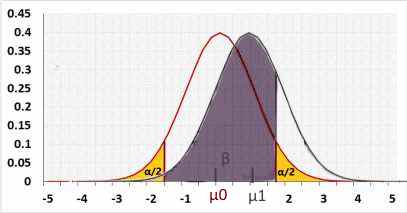
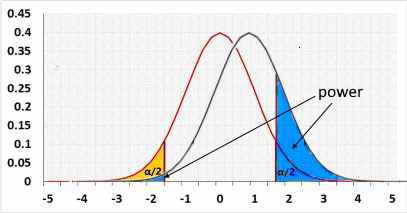
Left tail
Rejected H0 when statistic < R1.
H1 assumes the statistic is "lesser than" while H0 assumes "greater than". Hence the change/effect size should be negative.
Using a positive change will result in a small power because the statistic is actually "greater than", and supports H0, not H1.
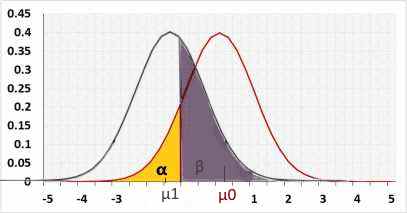
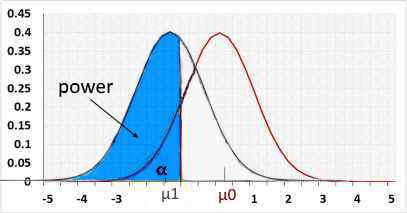
Right tail
Rejected H0 when statistic>R2.
H1 assumes the statistic is "greater than" while H0 assumes "lesser than". Hence the change/effect size should be positive.
Using a negative change will result in a small power because the statistic is actually "lesser than", and supports H0, not H1.
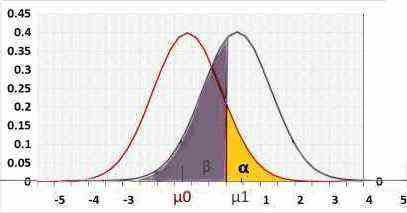
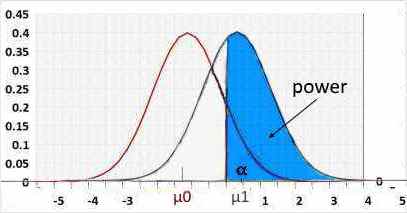
One sample z-test power
Expected Cohen's d: $$ d=\frac{\mu-\mu_0}{\sigma_{population}}=\frac{change}{\sigma_{population}} \\ statistic=\frac{\bar x-\mu_0}{\sigma_{statistic}} \\ H_0: \bar x \sim N(\mu_0 , \sigma_{statistic}) \\ H_1: \bar x \sim N(\mu_0 + change , \sigma_{statistic}) \\ \sigma_{statistic}={\frac{\sigma_{population}}{\sqrt{n} }} \\ $$Two tailed
Assuming μ1 > μ0 assuming the opposite will have the same result. $$ \mu>\mu_0 \;\rightarrow change=\mu-\mu_0\\ R_1=\mu_0+Z_{\alpha/2}\,\sigma_{statistic} \\ R_2=\mu_0+Z_{1-\alpha/2}\,\sigma_{statistic} \\ \beta=p(R_1 < statistic < R_2\,|\,H1) \\ =p(statistic < R_2)-p(statistic < R_1) \\ =p(Z < \frac{R_2-\mu_0 -change}{\sigma_{statistic}})-p(Z < \frac{R_1-\mu_0-change}{\sigma_{statistic}}) \\ =p(Z < \frac{\mu_0+Z_{1-\alpha/2}\;\sigma_{statistic}-\mu_0 -change}{\sigma_{statistic}})-p(Z < \frac{\mu_0+Z_{\alpha/2}\;\sigma_{statistic}-\mu_0-change}{\sigma_{statistic}}) \\ =p(Z < Z_{1-\alpha/2}-\frac{change}{\frac{\sigma_{population}}{\sqrt{n} }})-p(Z < Z_{\alpha/2}\ - \frac{change}{\frac{\sigma_{population}}{\sqrt{n} }}) \\ \beta= p(Z < Z_{1-\alpha/2} - d\sqrt{n}) - p(Z < Z_{\alpha/2} - d\sqrt{ n}) \\ \bf power=1-p(Z < Z_{1-\alpha/2} - d\sqrt{ n}) + p(Z < Z_{\alpha/2} - d\sqrt{ n }) $$Right tail
$$ \mu>\mu_0 \;\rightarrow change=\mu-\mu_0\\ R_2=\mu_0+Z_{1-\alpha}\,\sigma_{statistic} \\ \beta=p(statistic < R_2\,|\,H1) \\ =p(Z < \frac{R_2-\mu_0 -change}{\sigma_{statistic}}) \\ =p(Z < \frac{\mu_0+Z_{1-\alpha}\,\sigma_{statistic}-\mu_0 -change}{\sigma_{statistic}}) \\ =p(Z < Z_{1-\alpha}-\frac{change}{\frac{\sigma_{population}}{\sqrt{n} }}) \\ \beta= p(Z < Z_{1-\alpha} - d\sqrt{n})\\ \bf power=1-p(Z < Z_{1-\alpha} - d\sqrt{ n}) $$Left tail
The same as right tail.Two sample z-test power
Change - the change between the groups we expect the test to identify, reject the H0 if the difference between the groups is equals or greater than change.Expected Cohen's d: $$ d=\frac{\mu_2-\mu_1}{\sigma_{pool}}=\frac{change}{\sigma_{pool}} \\ \sigma_{pool}=\frac{\sigma1+\sigma2}{2}\\ H_0: (\bar x_2-\bar x_1) \sim N(0 , \sigma_{statistic}) \\ H_1: (\bar x_2-\bar x_1) \sim N(change , \sigma_{statistic}) \\ \sigma_{statistic}=\sqrt{ {\frac{\sigma_1^2}{n_1}+\frac{\sigma_2^2}{n_2}} } \\ $$ Lets define npool as: $$ n_{pool}=\frac{ n_1n_2(\sigma1^2+\sigma_ 2^2) }{ 2(n_2\sigma_1^2+n_1\sigma_2^2) }\\ $$ In the following calculation I chose μ2 to be the value toward the tail in the one tail calculation, and toward the right tail in the two tailed calculation
An opposite assumption will have the same result.
Two tailed
The calculation is based on the following assumption, but the opposite assumption will have the same final result.$$ \mu_2 > \mu_1 \;\rightarrow change=\mu_2-\mu_1\\ R_1=0+Z_{\alpha/2}\,\sigma_{statistic} \\ R_2=0+Z_{1-\alpha/2}\,\sigma_{statistic} \\ \beta=p(R_1 < statistic < R_2\,|\,H1) \\ =p(statistic < R_2)-p(statistic < R_1) \\ =p(Z < \frac{R_2-change}{\sigma_{statistic}})-p(Z < \frac{R_1-change}{\sigma_{statistic}}) \\ =p(Z < \frac{Z_{1-\alpha/2}\,\sigma_{statistic}-change}{\sigma_{statistic}})-p(Z < \frac{Z_{\alpha/2}\,\sigma_{statistic}-change}{\sigma_{statistic}}) \\ \beta=p(Z < Z_{1-\alpha/2}-\frac{change}{\sigma_{statistic}})-p(Z < Z_{\alpha/2}-\frac{change}{\sigma_{statistic}}) \\ or \: \beta= p(Z < Z_{1-\alpha/2} - d\sqrt{ n_{pool}}) - p(Z < Z_{\alpha/2} - d\sqrt{ n_{pool} }) \\ \bf power=1-p(Z < Z_{1-\alpha/2} - d\sqrt{ n_{pool}}) + p(Z < Z_{\alpha/2} - d\sqrt{ n_{pool} }) $$
Right tail
$$ \mu_2 > \mu_1 \;\rightarrow change=\mu_2-\mu_1\\ R_2=0+Z_{1-\alpha}\,\sigma_{statistic} \\ \beta=P(statistic < R_2 | H_1) = p(Z < \frac{R_2-change}{\sigma_{statistic}}) =p(Z < \frac{Z_{1-\alpha}\sigma_{statistic}-change}{\sigma_{statistic}} ) \\ \beta=p(Z < Z_{1-\alpha} - \frac{change}{\sigma_{statistic}}) \;or\; \beta =p(Z < Z_{1-\alpha} - d\sqrt{ n_{pool} })\\ $$ When calculate the sample size we can define n1=n2. $$\beta=p(Z < Z_{1-\alpha} - d\sqrt{n_1}) \\ \bf power=1-p(Z < Z_{1-\alpha} - d\sqrt{n_1}) \\ $$Left tail
The result will be identical to the right tail. $$ \mu_2 < \mu_1 \;\rightarrow change=\mu_1-\mu_2\\ R_1=0+Z_{\alpha}\,\sigma_{statistic} \\ power=p( statistic < R_1) = p(Z < \frac{R_1-change}{\sigma_{statistic}}) \\ =p(Z < \frac{Z_{\alpha}\sigma_{statistic}-change}{\sigma_{statistic}} ) \\ power=p(Z < Z_{\alpha}- \frac{change}{\sigma_{statistic}} ) \\ \bf power=p(Z < Z_{\alpha} + d\sqrt{n_1}) $$ It is the same result as the right tail: $$ power= p(Z < -Z_{1-\alpha} + d\sqrt{n_1})=p(Z < -(Z_{1-\alpha} - d\sqrt{n_1}) )\\ = p(Z > Z_{1-\alpha} - d\sqrt{n_1}) \bf=1 - p(Z < Z_{1-\alpha} - d\sqrt{n_1} ) $$T-test power
t distribution - When H0 assumes to be correct the t statistic distribute t.
noncentral-t distribution (NCT) - When H1 assumes to be correct the t statistic distribute noncentral-t.
$$ H_0: (statistic) \sim \color{blue}{t\,}(df) \\ H_1: (statistic) \sim \color{blue}{noncentral t}(df , noncentrality) \\ $$
The paired t-test, after calculating the differences between the two groups, behave exactly as one sample t-test over the differences.
Change=μ-μ0
Expected Cohen's d: $$d=\frac{\mu-\mu_0}{S}=\frac{change}{S} \\ statistic=\frac{\bar x-\mu_0}{S_{statistic}} \\ S_{statistic}=\frac{S}{\sqrt{n} } $$ n - sample size
S - the sample standard deviation of the population
df = n - 1
$$noncentrality=\frac{change}{S_{statistic}}=\frac{change}{\frac{S}{\sqrt{n}}}=d\sqrt{n}$$ Two Sample
Change=μ2-μ1
$$ d=\frac{\mu_2-\mu_1}{s_{population}}=\frac{change}{s_{population}} \\ S_{statistic}=\sqrt{\frac{(n_1-1)s_1^2+(n_2-1)s_2^2}{n_1+n_2-2}} \\ $$ S - the sample standard deviation of the population
$$ df = n_1+n_2-2 \\ noncentrality=\frac{change}{S_{statistic}}=\frac{change}{ S \sqrt{ \frac{1}{n_1}+\frac{1}{n_2} } }=d\sqrt{n}\\ $$ Lets define n as: $$ n=\frac{1}{\frac{1}{n_1}+\frac{1}{n_2}}\\ $$
Two tailed
Since it is two tail, choosing positive change or negative change will support identical result.For this calculation I chose a positive change (change > 0)
$$ R_1=\mu_0+T_{\alpha/2} \, \sigma_{statistic} \\ R_2=\mu_0+T_{1-\alpha/2} \,\sigma_{statistic} \\ \beta=p(R_1 < statistic < R_2 \, | \, H1) \\ =p(statistic < R_2) - p(statistic < R_1) \\ =F_{df , d\sqrt{n} }(R_2) - F_{df,d\sqrt{n}}(R_1) \\ =F_{df , d\sqrt{n} }(R_2) - F_{df,d\sqrt{n}}(\mu_0+T_{\alpha/2} \, \sigma_{statistic}) \\ $$ $$ \beta= p(T < T_{1-\alpha/2} - d\sqrt{n}) - p(T < T_{\alpha/2} - d\sqrt{ n}) \\ \bf power=1-p(T < T_{1-\alpha/2} - d\sqrt{ n}) + p(T < T_{\alpha/2} - d\sqrt{ n }) $$
Right tail
H1 assumes μ > μ0 => change > 0$$ R_2=\mu_0+T_{1-\alpha}\,\sigma_{statistic} \\ \beta=p(statistic < R_2\,|\,H1) \\ =p(Z < \frac{R_2-\mu_0 -change}{\sigma_{statistic}}) \\ =p(Z < \frac{\mu_0+Z_{1-\alpha}\;\sigma_{statistic}-\mu_0 -change}{\sigma_{statistic}}) \\ =p(Z < Z_{1-\alpha}-\frac{change}{\frac{\sigma_{population}}{\sqrt{n} }}) \\ \beta= p(T < T_{1-\alpha} - d\sqrt{n}) \\ \bf power=1-p(T < T_{1-\alpha} - d\sqrt{ n}) $$
Left tail
The same as right tail.Chi-squared test power
Chi-squared distribution - When H0 assumes to be correct the test statistic distribute chi-squared.
Noncentral-chi-squared distribution - When H1 assumes to be correct the test statistic distribute noncentral chi-squared .
$$ H_0: (statistic) \sim \color{blue}{\chi^2\,}(df) \\ H_1: (statistic) \sim \color{blue}{noncentral\ \chi^2}(df, noncentrality) \\ $$
Right tail
H1 assumes change > 0w - required effect size.
$$ R_2=\chi^2_{1-\alpha}(df) \\ noncentrality=nw^2\\ \beta=p(statistic < R_2\,|\,H1) \\ \beta=noncentral \chi^2(R_2,df,nw^2)\\ \bf power=1-noncentral\ \chi^2(R_2,df,nw^2)\\ $$